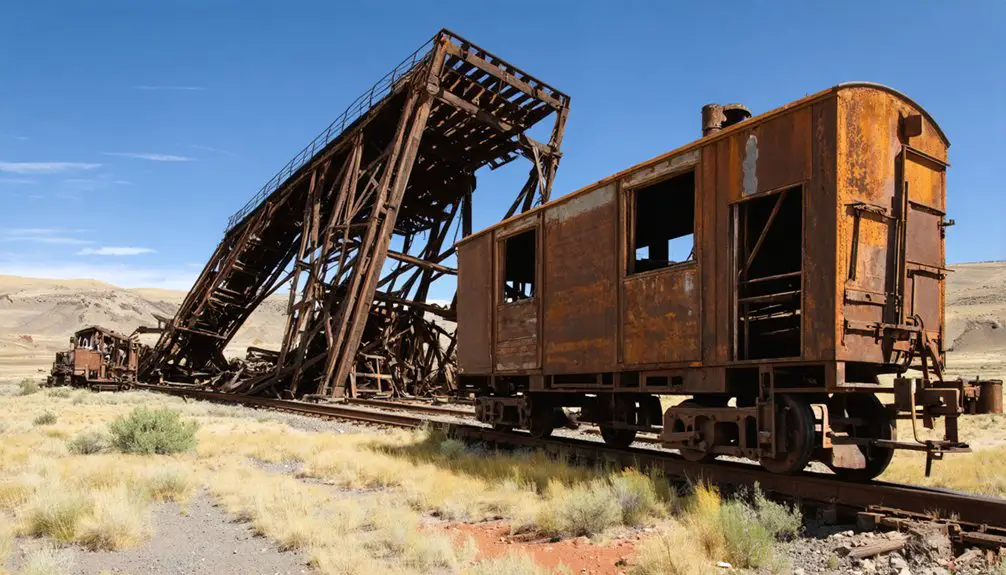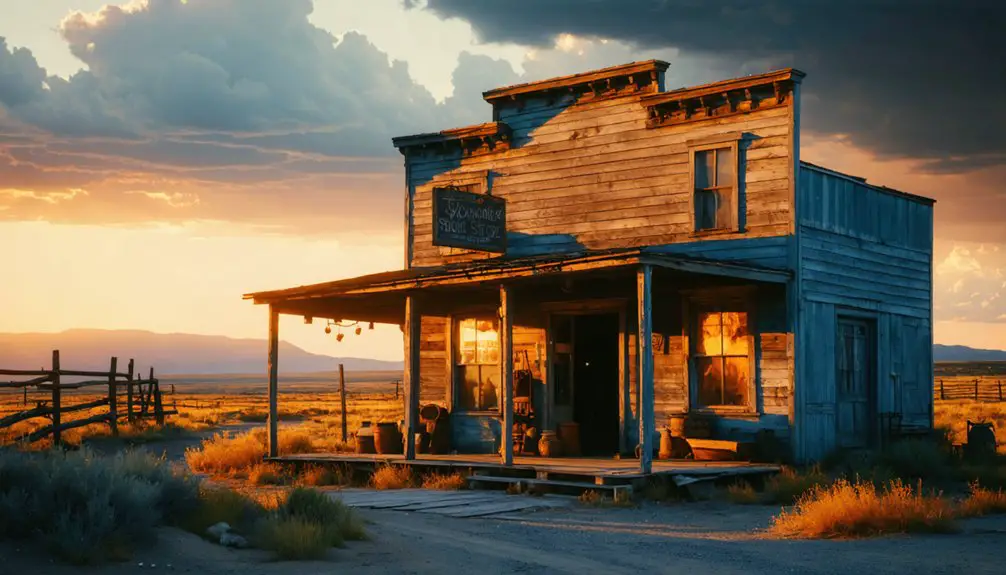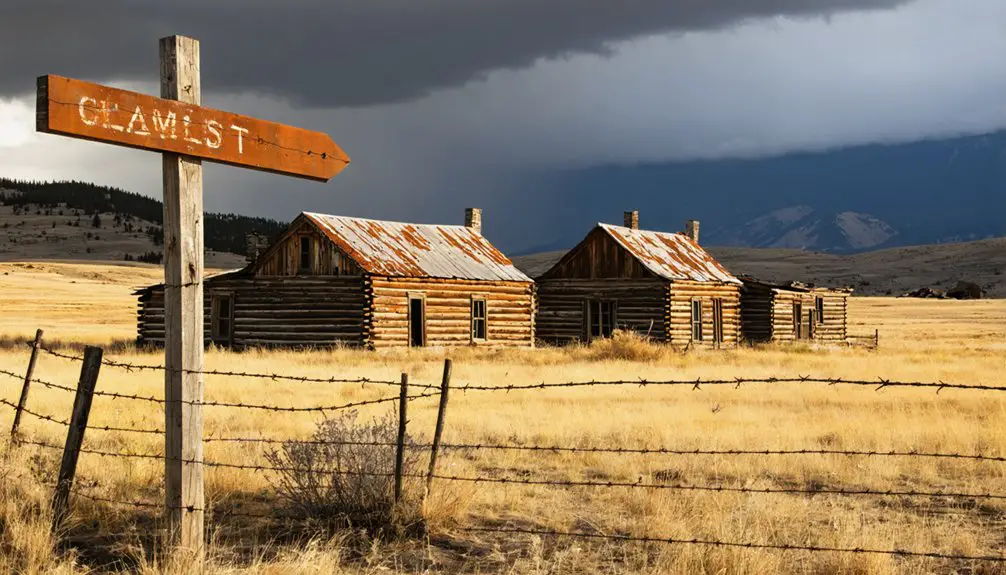You’ll find the ghost town of Rudefeha perched at 10,000 feet in Wyoming’s Medicine Bow Mountains, where copper mining operations thrived from 1897 to 1908. The town’s claim to fame was North America’s longest aerial tramway system, stretching 16 miles across the Continental Divide. Today, you can explore the remaining log cabins, historic mill, and two-story boarding house that tell the story of this innovative mining settlement’s dramatic rise and fall.
Key Takeaways
- Rudefeha was a copper mining town founded in 1897 by Ed Haggarty, producing 23 million pounds of copper before its decline in 1908.
- The town featured North America’s longest aerial tramway system, spanning 16 miles across the Continental Divide for ore transport.
- Located at 10,000 feet elevation, Rudefeha’s remains are accessible via Highway 230 and Highway 70, requiring snowshoes in winter.
- Historic structures still standing include log cabins, a historic mill, and a two-story boarding house from the mining era.
- The ghost town now attracts heritage tourists and preservationists working to protect its surviving structures from weather and vandalism.
The Birth of a Mining Empire
While the American West has countless tales of mineral discoveries that transformed landscapes overnight, few compare to the dramatic birth of the Rudefeha mining empire in 1897.
You’ll find its origins in the keen eye of Ed Haggarty, an English sheep herder who stumbled upon a rich copper deposit while tending his flock. His discovery sparked a remarkable series of mining partnerships that would shape Wyoming’s future.
The venture’s very name reflects its founding investors – Rumsey, Deal, Ferris, and Haggarty – though George Ferris would eventually emerge as the principal owner. The operation became incredibly successful, producing 23 million pounds of copper ore throughout its lifetime.
The clever acronym Rudefeha captured its founders’ names, though Ferris would ultimately take the reins of this mining enterprise.
With Chicago promoter Willis George Emerson’s marketing prowess and mining engineer William Weston’s technical expertise, copper exploration at Rudefeha quickly evolved from a simple claim into a sophisticated operation, complete with essential buildings and infrastructure by winter’s end. The town’s growth led to the establishment of Dillon in 1904, positioned strategically south of the Rudefeha Mine.
The Revolutionary Aerial Tramway System
You’ll be fascinated to learn that Rudefeha’s aerial tramway was North America’s longest ore transport system, stretching 16 remarkable miles across the Continental Divide with nearly 375 towers supporting its 840 ore buckets.
The tramway’s construction in 1902 revolutionized mining operations, enabling the transport of up to 1,000 tons of ore daily at just 7 cents per ton, compared to the previous wagon cost of $14 per ton.
The system’s water-powered, gravity-assisted technology moved ore buckets at 4 miles per hour through three transfer stations, making the once-impossible task of efficient mountain mining a profitable reality. Built by the Riblet Tramway Company, this innovative system helped establish their reputation as pioneers in aerial transportation technology. The highest spans reached an impressive 900 feet above ground, demonstrating the engineering marvel of this transportation system.
Longest Tramway In World
During the early 1900s, Rudefeha’s revolutionary aerial tramway system stretched an unprecedented 16 miles across Wyoming’s rugged mountain terrain, earning its place as the world’s longest tramway of its time.
This remarkable feat of mining technology connected the isolated Rudefeha Mine directly to the Grand Encampment smelter, transforming the region’s copper mining capabilities.
You’ll find that this aerial transport marvel could move an impressive 500 tons of ore daily at just 17 cents per ton, rendering obsolete the slower mule teams and wagon routes.
The system’s innovative engineering conquered challenging mountain passes, proving essential to the economic success of the entire mining district.
The tramway’s extensive reach didn’t just transport ore – it built communities, linking remote mining settlements and enabling unprecedented growth in towns like Dillon, Rambler, and Copperton.
The discovery of the valuable Ferris-Haggarty Mine in 1897 led to the tramway’s construction and the area’s copper mining boom.
By 1907, the once-bustling mining operations came to an end as both Dillon and Rudefeha became ghost towns.
Construction and Daily Operations
As construction crews broke ground in spring 1902, the Riblet Tramway Company of Spokane commenced on one of its first major engineering feats – a massive aerial system requiring 270 towers and over 439,000 pounds of cable.
You’d be amazed by the tramway construction’s scale, featuring towers soaring 900 feet high and spans stretching 2,270 feet across Cow Creek Canyon.
The daily logistics were equally impressive. Picture 840 ore buckets continuously moving along the cable, each carrying 700 pounds of ore across the Continental Divide at 10,690 feet elevation.
This engineering marvel slashed transport costs and shortened the route from 26 wagon miles to just 17 direct miles.
With transfer stations strategically placed along the line, the system could move 350 tons daily – a remarkable improvement over horse-drawn wagons. The tramway connected the rich deposits of the Ferris-Haggarty mine to the processing facilities at the Boston-Wyoming smelter. The first ore bucket made its historic journey on June 9, 1903, marking a triumphant moment for the mining operation.
Economic Impact on Mining
The revolutionary aerial tramway transformed the economics of mining in Rudefeha by slashing transportation costs from $14 to just 7 cents per ton.
You’ll see how this 16-mile marvel, stretching across the Continental Divide, enabled the movement of 350 tons of ore daily between the mine and the Boston-Wyoming Smelter.
Despite the tramway’s efficiency in managing economic fluctuations, Penn-Wyoming Copper Company’s financial mismanagement ultimately overshadowed the system’s benefits.
While mining profitability soared initially, fraudulent stock activities and false dividend declarations led to the company’s downfall.
The original Rudolph, Davis, Ferris, and Haggarty investors established multiple successful mines in the region before the economic collapse.
The ripple effects devastated surrounding settlements like Dillon, Copperton, and Rambler, which had flourished during the boom.
When the mines closed, these towns couldn’t survive, leaving behind abandoned infrastructure and environmental challenges that still impact the region today.
The discovery by George Doane in 1874 initially sparked this mining boom that would transform the Sierra Madre Mountains.
Life in a Company-Controlled Town
Life in Rudefeha exemplified the classic company town model, where mining operators wielded extensive control over residents’ daily activities and social behavior.
You’d find your housing, meals, and basic services all provided by the company, with strict oversight of your daily routines. If you lived there, you’d be one of about 100 workers housed in the two-story boarding house, sharing meals and sleeping quarters with your fellow miners.
The company’s iron grip extended beyond basic necessities – they even banned alcohol sales within town limits. You’d need to venture to nearby Dillon for a drink or entertainment away from the watchful eyes of mine operators.
While the company provided modern amenities like electric lighting and hospital care, you’d sacrifice personal freedom for the security of company-controlled accommodations and steady employment.
Mining Operations and Industrial Innovation

Mining operations at Rudefeha reached impressive heights during its peak in 1904, when you’d find 200 men working to extract copper worth over $1.4 million.
You’ll discover that pioneering mining techniques, developed with guidance from railroad engineer William Weston, helped transform this remote mountain operation into a significant industrial achievement.
The mine’s infrastructure showcased the era’s industrial challenges, from transporting ore via mule trains to the Encampment smelter to establishing essential facilities like bunkhouses and eating houses.
Despite adopting modern machinery where possible, Rudefeha’s success relied heavily on manual labor and animal power.
Ultimately, a perfect storm of factors – including smelter fires, rising operational costs, and plummeting copper prices – brought mining operations to a halt by 1908, leading to foreclosure by 1913.
The Rise and Fall of Rudefeha’s Economy
During Rudefeha’s early development, you’d find a bustling economy centered around the ambitious copper mining venture established by prominent investors JM Rumsey, Robert Deal, George Ferris, and Ed Haggarty.
The town’s infrastructure quickly expanded with boarding houses, workshops, and a hospital, while mining sustainability improved through electrical lighting and efficient tramways.
Swift progress brought modern amenities and industrial improvements, transforming the mining town into a well-equipped community with essential services.
However, the economic fluctuations of 1908 devastated the region when copper prices plummeted.
The Penn-Wyoming Company’s questionable financial practices, including declaring dividends despite losses, led to their indictment for stock fraud.
You’d witness the rapid decline as mine shafts flooded, jobs vanished, and buildings deteriorated.
While some residents adapted through cattle ranching, hay production, and timber work, these activities couldn’t match the prosperity of the mining era.
Ghost Town Tourism and Preservation

While many Wyoming ghost towns fade into obscurity, Rudefeha’s remains have attracted growing interest from heritage tourism enthusiasts and preservation advocates.
You’ll find dedicated preservationists working to protect the town’s surviving structures from harsh Wyoming weather and vandalism, while balancing the need for public access with conservation goals.
Heritage tourism has breathed new life into Rudefeha’s dusty streets.
You can now explore carefully maintained buildings, read interpretive signs about frontier life, and participate in seasonal events that celebrate the town’s mining heritage.
Local historical societies have partnered with state agencies to provide guided tours and educational programs, ensuring you’ll experience an authentic glimpse into Wyoming’s past.
Despite infrastructure challenges, Rudefeha’s ghost town preservation efforts continue to draw visitors seeking connection with the American West’s untamed spirit.
Exploring the Historic Ruins Today
You’ll find the preserved remnants of Rudefeha’s mining legacy scattered through the forested landscape at 10,000 feet elevation, including collapsed boarding houses, bunkhouses, and fragments of what was once the world’s longest tramway system.
To reach these historic ruins, you’ll need to navigate Highway 230 south from Saratoga and then take Highway 70 west towards Encampment, being mindful that winter conditions often require snowshoes or skis for access.
For the safest exploration, it’s crucial to plan your visit during favorable weather conditions and bring appropriate navigation tools, as the dense forest surrounding the ruins can make orientation challenging.
Preserved Buildings and Structures
Today’s visitors to Rudefeha will find an impressive collection of preserved structures that paint a vivid picture of early 20th-century mining life.
You’ll discover log cabins with their first few layers intact, a historic mill, and the architectural significance of the two-story boarding house that once housed 80 miners.
The town’s preserved structures showcase remarkable engineering feats, including original 1904 electrical fixtures and what was once the world’s longest aerial tramway at 16 miles.
- Original log foundations reveal authentic frontier construction techniques
- Preserved mining infrastructure demonstrates industrial innovation
- Surviving buildings represent both working-class and management housing styles
- The two-story boarding house exemplifies communal living arrangements
- Early electrical systems showcase the town’s technological advancement
Planning Your Ghost Town Visit
Planning a successful visit to Rudefeha’s historic ruins requires careful preparation and attention to practical details. You’ll need a high-clearance vehicle to navigate the rough terrain, and you should be prepared to hike the final stretch along unmarked trails.
Pack plenty of water, emergency supplies, and weather-appropriate gear before setting out.
For the best ghost town photography opportunities, arrive early in the day when lighting conditions are ideal. Research the site’s history beforehand through local museums and historical societies to enhance your exploration.
While hiking trails aren’t formally marked, you can follow established paths between structures. Remember to inform someone of your plans, as cell service is unreliable in this remote area.
Always practice Leave No Trace principles and avoid disturbing any artifacts you encounter.
Legacy of Wyoming’s Copper Mining Era
While Wyoming is primarily known for its coal industry, the state’s copper mining era left an indelible mark on its economic and cultural landscape. From the late 1800s through early 1900s, copper extraction transformed regions like Carbon and Goshen Counties, spawning boomtowns and driving infrastructure development.
Mining legislation shaped the industry’s growth, particularly in districts like Grand Encampment, where the Ferris-Haggarty mine ranked among the world’s top producers.
- The copper boom created a network of interconnected communities, many now ghost towns.
- Early mining operations pioneered industrial-scale resource extraction in Wyoming.
- Diverse mineral deposits showcased Wyoming’s geological richness beyond coal.
- Mining districts attracted skilled workers and entrepreneurs from across America.
- The era’s infrastructure, including railways and mill sites, still dots the landscape today.
Frequently Asked Questions
What Wild Animals Were Commonly Encountered by Miners in Rudefeha?
You’d face wildlife encounters from bears, mountain lions, and rattlesnakes as major mining hazards, while dealing with pesky coyotes, deer, and ravens scavenging around your camp daily.
How Many Deaths Occurred in the Rudefeha Mines During Operations?
You’ll find incomplete historical fatalities records, with only Earl M. Hadley’s 1905 death and several avalanche victims confirmed. Mine safety challenges and sparse documentation prevent determining the total death count accurately.
What Happened to the Mining Equipment After the Town Was Abandoned?
You’ll find most mining equipment was removed or scrapped during liquidation, though some tramway pieces survive at the Grand Encampment Museum. Underground machinery lies submerged in flooded shafts of this ghost town.
Were There Any Notable Crimes or Shootouts in Rudefeha’s History?
You won’t find documented shootouts here, though local legends hint at unsolved mysteries. Historical records focus more on company control pushing troublemakers to neighboring towns like Dillon.
What Was the Average Monthly Wage for Miners at Rudefeha?
You won’t find exact average salaries for miners during this period, though related operations paid $40,000 monthly total. Based on regional patterns, individual miner living wages likely ranged between $2-4 daily.
References
- http://userpages.aug.com/bdobson/rudafeha.html
- https://www.rv.com/archive/wyomings-spook-route/
- http://www.wyomingtalesandtrails.com/rudafeha.html
- http://www.wyomingtalesandtrails.com/rudafeha2.html
- https://www.wyomingcarboncounty.com/blog/123-5-ghost-towns-to-explore
- https://wyoshpo.wyo.gov/index.php/programs/national-register/wyoming-listings/view-full-list/432-ferris-haggarty-mine-site
- https://en.wikipedia.org/wiki/Ferris-Haggarty_Mine_Site
- https://www.wyohistory.org/encyclopedia/encampment-wyoming
- https://clui.org/ludb/site/rudefeha-mine-site
- https://www.wylr.net/2021/08/06/worlds-longest-tramway/



